In this article, you’ll find gentle exercise ideas for puppies when they’re still too young to go running or biking, do agility, and similar strenuous activities.
I realize exercising and socializing a puppy is extra challenging right now due to Covid-19, but we hope this post gives you some ideas for both now and later this spring & summer!
It takes puppies 12-18 months to complete their growth phase, and during this time they need age-specific exercise that’s safe for their growing bodies.
Finding the right balance for puppies
Exercising growing puppies can be a bit of a balancing act. On the one hand, puppies are little bundles of energy who need a regular outlet for it all.
On the other hand, their growing joints and bones can easily be damaged when they experience too much stress.
However, we can’t just place our little ones into a bubble while we wait for them to exit puppyhood.
This restriction would cause a lot more health and behavioral problems later on down the road than gentle exercise does. That’s why it’s important to use common sense and not be too extreme with restricting their exercise.
See That Mutt’s article How far can I walk my puppy? for more information.
Exercise for puppies: what to wait on for now
It’s easy to damage the growing joints of puppies by exercising them as if they were adult dogs! That’s why you’ll definitely want to wait on the following activities:
- Hard running. Puppies do a decent amount of running in short bursts either way, so there’s no need to add any intentional running sessions on our part until your puppy is at least 6 months old. Ask your vet about what age your specific pup can safely start a running routine with you. So much depends on breed (as well as your pace). See Lindsay’s post: When is it safe to run with my puppy?
- Biking. The same goes for biking. Wait on this (for now). However, we do suggest to introduce your puppy to the concept of bikes and any other exercise equipment on wheels such as skateboards and rollerblades. Consider it part of your puppy’s socialization process.
- Heavy backpacks. We love backpacking with our dogs but waited to introduce our puppies to heavier backpack loads until they were about 12 months old. However, you can certainly expose your puppy to an empty backpack as soon as you bring her home. It’s also ok to get her used to wearing the empty backpack on her back. Just place it on her from time to time while showering her with praise and high-value treats.
- Lots of jumping in agility. Regular agility courses are not only high speed activities, they also consist of obstacles that require jumping. You definitely don’t want to encourage jumping quite yet, but you can certainly introduce her to simple agility elements like hoops and tunnels.
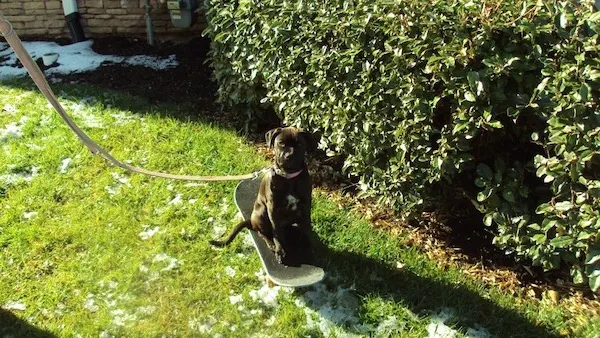
13 gentle exercise ideas for puppies
Now without further ado, here are our 13 gentle exercise ideas for puppies! Not only will they keep your puppy entertained, they’ll also create a strong bond between you and your pup as you’ll be spending quality time together.
Keep in mind that puppies have relatively short attention spans, and that multiple short exercise sessions work better for puppies than one really long activity.
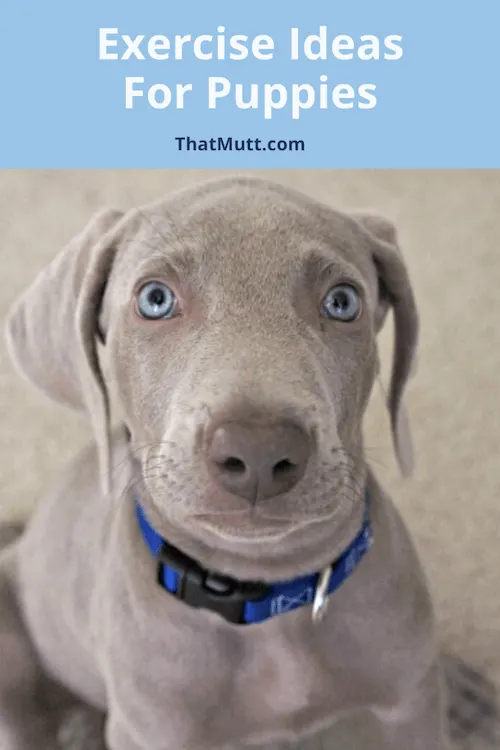
1. Exercise ideas for puppies: Low-impact walks & hikes
Most vets recommend that puppies wait to go for walks or hikes at public (state) parks, trails, and beaches until they’ve had their core puppy vaccinations. This is usually the case at 16 weeks of age (4 months).
However, you can still take your puppy on short walks around your neighborhood as long as they’ve had their first round of puppy vaccinations. When in doubt, ask your pup’s vet.
See our post: Can I walk my puppy before all her shots?
Walks around your neighborhood where they see and smell other people, plants, and objects on wheels like cars, bikes, skateboards, etc. are invaluable for their socialization.
Speaking of socialization, puppies are most impressionable during the first 4 months of their lives, so it’s really important to socialize them to the world around them as soon as possible.
Thankfully, most of us are still able to get out and walk our puppies and dogs right now, even though we can’t do much else!
Weekly puppy kindergarten classes are one option you can enroll your puppy. Most classes are closed for the time being, but hopefully things will change soon!
Puppy classes are great for letting puppies mingle with other puppies, experience other people, and introduce them to new sights and smells in general. Those classes require at least the first round of core vaccinations, so puppies can participate at around 8 weeks of age.
Another idea is to set up puppy playdates with friends who also have young dogs or friendly adult dogs. I
f none come to mind, check in with other puppy kindergarten participants to see if they’d be interested in getting together for play dates outside of class as well.
You could also check online platforms such as MeetUp.com for puppy group playdates.
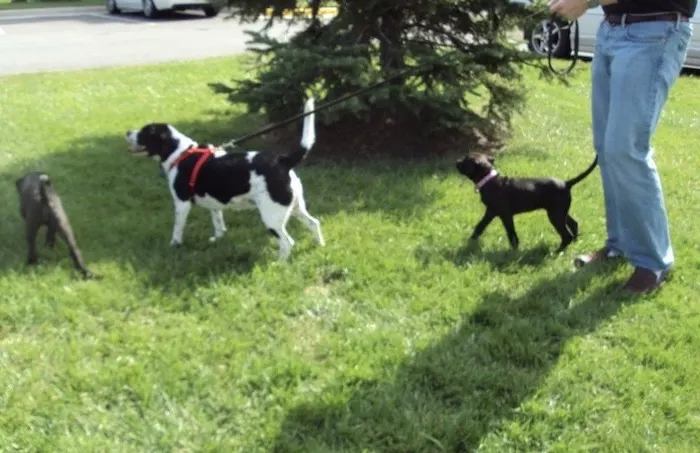
3. Puppy daycare
Daycare can be a safe setting for socializing puppies, and once again, we hope most dog daycares will be able to open up again soon!
Most daycare facilities have knowledgeable staff who supervise all dog on dog interactions. Ideally, newcomers at daycare slowly get introduced to the other dogs in order to avoid being overwhelmed. They also provide regular nap time in between play sessions.
See our post: Pros & cons of dog daycares.
Of course there are daycare facilities who have less knowledgable staff than others and who don’t make time to properly introduce a new dog into an existing group of daycare dogs. That’s why it’s a good idea to pay the facility a visit before actually taking your puppy there.
Ask for a tour without announcing yourself beforehand, and make sure to ask about their screening routine for newcomers.
Some daycare facilities such as Camp Bow Wow have very strict procedures set in place that test a new dog’s ability to safely be around a larger group of dogs.
4. Exercise ideas for puppies – dog parks
Dog parks are usually less safe for puppies than daycare because there’s no supervision of any kind, so you’re on your own. You also can’t control who else goes there. There might be dogs who aren’t well socialized and/or sick, and it’s best to avoid both.
Most dog parks don’t allow puppies under 16 weeks of age (4 months) and require them to have had all of their core puppy vaccinations.
5. Games for puppies
Games are a great way of exercising puppies because they engage them both mentally and physically. Some of them require basic obedience command knowledge like “stay” and understanding the puppy’s name. The following games are our favorite ones:
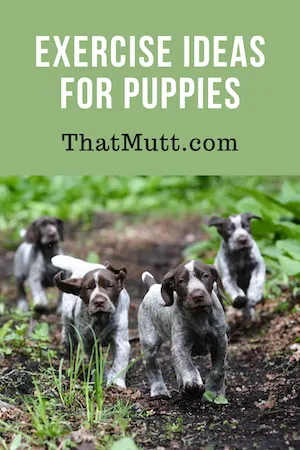
- Find it. Show your puppy something and then have them find it! Start with your puppy right next to you. Cover the object or treat you’ll want her to find with a blanket or towel so that she clearly knows where it is. When she locates it, praise and reward with a high value treat. Once she gets the idea, have her “stay” somewhere while you hide the item. Then ask her to find it.
- Hide and seek. The concept here is similar to the find it game, except that you’re asking your puppy to find YOU, and not an object. Ask your puppy to “stay”, then go away and hide somewhere, followed by calling your puppy’s name! Once she finds you, praise and reward.
- Puzzle toys. They make treat and/or feeding time extra fun because your puppy has to figure out how to get to her food! Puzzle toys we like are the stuffable classic KONG and Nylabone dog toys, as well as the Pet Zone IQ treat ball, Outward Hound’s Fun Feeder, and West Paw’s Zogoflex Qwizl.
6. Tricks for puppies
Much like games, learning how to perform tricks on command burns both physical and mental energy. It’s important to keep training sessions short and to always end them on a positive note. That way your puppy doesn’t get bored by too much repetition and she won’t lose interest in future trick training sessions!
Here are a few ideas for tricks you can teach your puppy:
- Shake. This is a classic trick that involves your puppy’s paws. See That Mutt’s article How to teach your dog to shake to learn how to teach it.
- Play dead. It’s a fun trick that teaches your puppy how to dramatically fall over onto her side and stay put. See our article How to teach a dog to play dead or Bang! for more information on how to teach it.
- Twirl. The twirl trick turns your puppy into a little dancer! See How to teach your dog to twirl and other tricks for more information.
- Crawl. Crawling is essentially an extended “down” with movement! We wrote about it in our article How to teach your dog to crawl and other tricks.
7. Basic nose work for puppies
Nose work is another fun yet mentally stimulating activity for your puppy (AND your adult dog, too). It’s all about exercising your puppy’s nose and teaching her to sniff out certain odors. The beauty of it is that it can be done both inside as well as outside. All you need for starters are high value treats. The smellier, the better!
Try some green tripe treats or anything fishy and your puppy’s nose will be in scent heaven. Alternatively you could also use your puppy’s dry food, although we do recommend a fresh, ideally raw diet, and plain dry food might just not be interesting enough.
Start by tossing some on the floor inside your home as there’s less distractions inside. Once your puppy does well inside, you can progress to the grass in your yard.
Encourage your puppy to sniff them out and praise when she finds them! Once she starts getting the hang of it, you can increase the difficulty by having her “stay” while you hide the treats instead of just tossing them on the floor.
When you want her to start sniffing out the treats, add the command “go sniff” or something similar.
You can up the ante by hiding a treat in one of your closed hands. Show her both hands and let her figure out which hand holds the food jackpot!
8. Tug with rules
Another fun game is playing tug, but with rules! Tug is a great way of teaching your puppy bite inhibition. After all, puppy teeth are sharp, and you’ll also want to set the foundation for gentle playtime behavior for your older dog.
Longer ropes and rubber toys with multiple rings or arms make great tug toys. You want your puppy to learn that she needs to let go of the toy when you tell her to, so this game is great for teaching the “leave it” or “drop it” command.
To do this, arm yourself with high value treats your puppy is willing to leave the toy for. After 30 seconds or so of tugging, stop playing and offer your puppy a treat. When she lets go of the tug toy, praise her and add the command “leave it”. She’ll soon learn that tugging only happens on your terms.
9. Puppy obedience training
Puppies can start learning basic obedience commands once they’re 7-8 weeks old. Start with the basics like “sit”, “down”, “stay”, and “come”.
The easiest way of teaching those is by naming and rewarding the behavior your puppy already performs on her own. This is called “capturing”. When she decides to sit, add the command and reward her for it! Do she same when she lies down or comes running your way.
Another method of teaching those commands is by breaking them down into smaller steps. You’ll reward each step with praise and a training treat until she’s able to perform the command in one movement. This is called “shaping.”
10. Swimming with your puppy
Swimming is a low-impact exercise that’s very gentle on a puppy’s growing joints (also great for aging joints of a senior pup).
If you don’t have the luxury of your own pool, many pet spas and rehabilitation facilities offer doggie specific indoor pools. A simple internet search will help you locate the closest one to your home.
You could also take your puppy swimming in local lakes and ponds. However, you’ll want to be aware of your local wildlife such as water snakes and toxic plants like blue-green algae. It’s a good idea to invest in a doggie life vest and a long lead you can use to reel your puppy back in if necessary.
11. Fetch for puppies
Puppies can play fetch as long as you throw the frisbee or whatever other toy fairly low to the ground. Avoid tossing it high into the air so that your puppy isn’t encouraged to jump high and far for it.
We suggest choosing a flexible rubber frisbee like the KONG Flyer that’s gentle on your puppy’s gums and teeth. Hard plastic ones have the potential to cause serious cuts and wear down teeth.
12. Very simple agility
Puppies shouldn’t be asked to do any agility that requires a lot of jumping, but they can certainly be introduced to simple elements of agility.
Those can be tunnels as well as balance boards like the FitPAWS Wobble Board with a non-slip surface. The latter is great for working on balance and core strength, as well as to get used to movement.
Learn more about agility for puppies here.
13. Exploring on a long leash is great exercise for a puppy!
We mentioned a long leash for taking your puppy swimming, but of course you can also use it on dry land!
Simply attach it to your puppy’s collar or harness and let her explore her surroundings. You can do this in your neighborhood, a local park or even on the beach once she’s had her core puppy vaccinations.
Another good use of a long leash is to practice coming when called. If your puppy doesn’t respond right away, you can use the leash to reel her in. Don’t forget to praise and reward once she comes your way!
Signs of too much exercise in a puppy
We suggest to always observe your puppy’s behavior and body language during and after exercise sessions. If you notice any of the following symptoms, it’s time to slow things down:
- Lameness. If your puppy is limping, she may very well have had too much exercise and been running around too much.
- Cracked paw pads. Additionally, intense exercise sessions can cause irritated and even cracked paw pads, especially if the surface she ran on was too hot or sharp. Clean her paw pad under running warm water and let it dry, then apply some paw pad balm that’ll help soften the pad and heal it.
- Excessive tiredness. If your puppy just doesn’t seem to want to move around and engage in happy-go-lucky puppy behavior, her body likely needs to recover from too much exercise.
Should your puppy’s condition improve after a day or two of rest, it’s probably not necessary to take her to the vet.
However, we recommend scheduling an appointment if your puppy continues to seem lethargic or if the cut on her paw pad is so deep that it won’t stop bleeding.
The importance of rest and downtime for puppies
This brings us to the importance of rest and downtime for puppies. They actually need more of both than we think!
That’s because their bodies need the rest to grow and process what they’ve just experienced. Very young puppies sleep up to 22 hours per day, which is why you’ll even notice them fall asleep while they’re running around.
Older puppies still sleep quite a bit, somewhere between 16-20 hours per day. Sometimes they’ll appear to be overly excited and hyper, especially in the evenings, which is a sign of overstimulation! The best solution for this is a nap, much like with kids who get cranky when they’re tired.
This is the perfect opportunity to introduce puppies to the concept of crates. They’ll be able to rest and relax in their very own safe space.
See That Mutt’s article Dog and Puppy Crate Training for more information on how to successfully crate train your puppy.
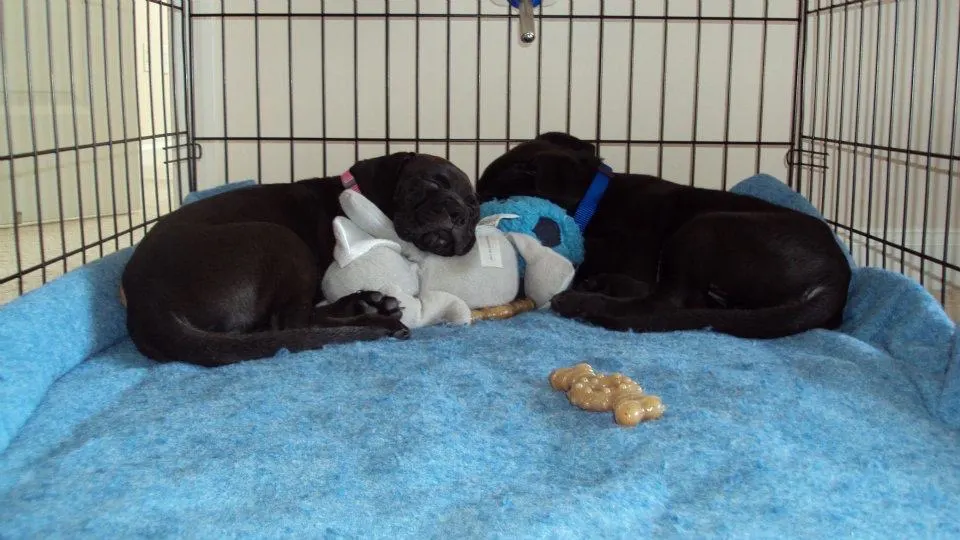
Now we’d like to hear from you!
Now it’s your turn! Have you tried any of these gentle exercise for puppies? Do you have any additional suggestions?
If you have any questions, let us know in the comments!
Barbara Rivers writes regularly for That Mutt. She is certified in raw dog food nutrition from Dogs Naturally Magazine and the author of three ebooks about balanced raw dog food. She is a blogger at K9s Over Coffee.

Clare Furlonger
Monday 3rd of May 2021
I notice you have two puppies - Missy and Buzz. My sister and I live together and have two six month old puppies. We are working hard to make them independent of each other as well as spending great times together. Any advice welcome but particularly related to confidence outside the house. We do their main walk separately and a shorter evening one together but one puppy is clearly less confident than the other and tends to follow in the others shadow and be slightly nervous on her own individual walks (although fine with people and other dogs).
Lindsay Stordahl
Monday 3rd of May 2021
Doing some separate walks like you're doing should help and just crating them separately (not same crate), if you use a crate. Making a point to occasionally leave one home and bring one along when you run errands and such. And randomly crate one and not the other when you're home - just giving them time separated so it is a normal thing. Here is our post on raising littermates: https://www.thatmutt.com/2020/01/16/raising-littermates-two-puppies/
Stacey Kline
Thursday 16th of April 2020
Love these ideas...especially the gentle ideas! This will keep our dog & kids busy during this home isolation time!
Bronwyn Warden
Monday 13th of April 2020
We have the overstimulation in the evening problem. Our labradoodle is 11 weeks old. Her naps in the daytime can be up to 1.5hrs but only if I sit with her. I tried locking her in the crate today when I knew she was tired but slept for only 30mins before crying to get out. What to do? Persist with crate or wait until she settles at my feet then try crate again?